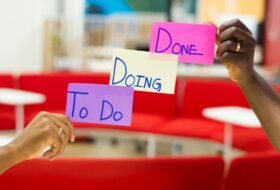As leaders and continuous improvement practitioners, one of the biggest challenges we face is shifting our focus from simply “doing” to truly “being.” It involves finding the delicate balance between achieving business outcomes and developing the people around us. In this blog post, we will explore the importance of this shift and its impact on long-term sustainable change, engagement, and innovation.
The Pitfalls of “Doing” without Teaching
Have you ever found yourself so focused on applying the technical side of problem-solving that you forget to teach others the tools? While it may seem efficient to tackle problems on your own, this approach limits the growth and development of your team members. By taking the time to teach and empower others with problem-solving skills, you not only foster a culture of continuous improvement but also create a more engaged and innovative workforce.
The Power of Creating Space for Contribution
Another common pitfall is jumping in with your answers without giving others the space to contribute. While your expertise and experience may be valuable, it is equally important to allow others to share their insights and ideas. By creating an environment that encourages collaboration and open dialogue, you tap into the collective intelligence of your team, leading to more creative and effective solutions.
The Importance of Consultation in Strategic Planning
Completing strategic plans without consulting team members may seem efficient in the short term, but it often leads to a lack of buy-in and ownership. When team members are not involved in the decision-making process, they may feel disconnected from the goals and objectives of the organization. By involving them in strategic planning, you not only gain diverse perspectives but also foster a sense of ownership and commitment to achieving the desired outcomes.
Striking the Balance: Being and Doing
While the “doing” actions mentioned earlier may help get a project “done,” they are unlikely to result in the long-term sustainable change, engagement, and innovation that we strive for as leaders. It is essential to shift our focus from simply completing tasks to embodying the qualities of a true leader – being present, empowering others, and fostering a culture of continuous improvement.
When we prioritize “being” over “doing,” we create an environment where individuals feel valued, motivated, and empowered. We invest in their growth and development, knowing that their success ultimately contributes to the success of the organization. By balancing business outcomes with personal development, we not only achieve short-term results but also lay the foundation for long-term sustainable change.
The Impact of Shifting from Doing to Being
In my podcast, I share real-life examples of the challenges and impact of shifting from doing to being. By embracing this shift, organizations have experienced increased employee engagement, improved problem-solving capabilities, and a culture of innovation. It is through this transformation that organizations can thrive in today’s rapidly changing business landscape.
Conclusion
Shifting our focus from doing to being is a transformative journey that requires us to balance business outcomes with personal development. By teaching others the tools of problem-solving, creating space for contribution, and involving team members in strategic planning, we foster a culture of continuous improvement and innovation. Embracing this shift not only leads to short-term success but also sets the stage for long-term sustainable change, engagement, and innovation.
Are you ready to make the shift?









